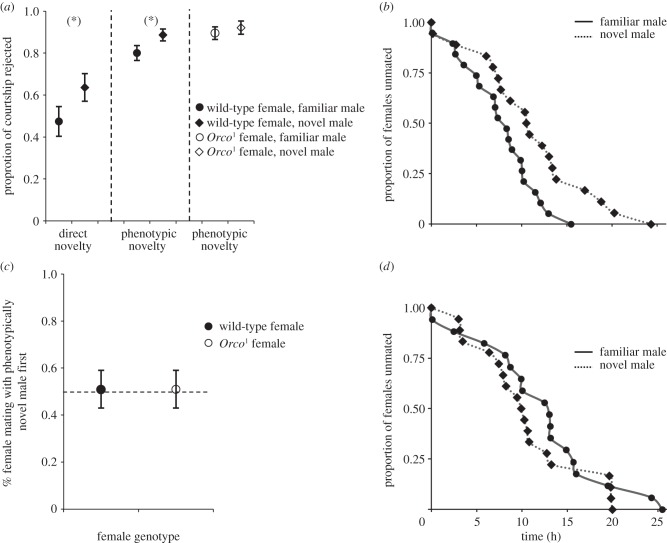Figure 2.
Female responses to direct and phenotypic familiarity of males. (a) Proportion of courtship rejected by females. From left to right: ‘direct familiarity’ experiment in which wild-type females were presented with a previous mate and novel mate (n = 43); ‘phenotypic novelty’ experiment in which wild-type females were presented with a full-sibling of their first mate who had developed in the same vial as that male (phenotypically familiar), and one male who was unrelated to the first mate and from a different vial (phenotypically novel; n = 59); ‘phenotypic novelty’ experiment in which Orco1 females were presented with a brother of their first mate who had developed in the same vial as that male (phenotypically familiar), and one male who was unrelated to their first mate and from a different vial (phenotypically novel; n = 56). Dashed lines separate different experiments. Asterisk (*) equals 0.05 < p < 0.10 for tests for difference in proportion of courtship rejected between familiar and novel males. p-values from left to right are 0.088, 0.082 and 0.176. (b) Cumulative survival functions for wild-type females. Likelihood ratio tests revealed a significant difference in remating latency with phenotypically familiar and phenotypically novel mates (n = 40,  , p = 0.019). (c) Proportion of females mating with a novel male first in the phenotypic novelty experiment. Focal females were either wild-type or Orco1 and were presented with a brother belonging to the same local environment as the first mate (phenotypically familiar) and one non-sibling belonging to a different local environment as the first mate. (d) Cumulative survival functions for Orco1 females. Likelihood ratio tests revealed no significant difference in remating latency with phenotypically familiar and novel mates (n = 35,
, p = 0.019). (c) Proportion of females mating with a novel male first in the phenotypic novelty experiment. Focal females were either wild-type or Orco1 and were presented with a brother belonging to the same local environment as the first mate (phenotypically familiar) and one non-sibling belonging to a different local environment as the first mate. (d) Cumulative survival functions for Orco1 females. Likelihood ratio tests revealed no significant difference in remating latency with phenotypically familiar and novel mates (n = 35,  , p = 0.344). Error bars denote s.e.
, p = 0.344). Error bars denote s.e.

